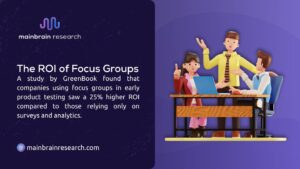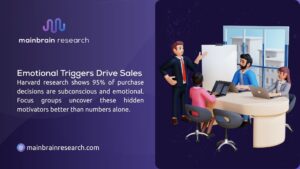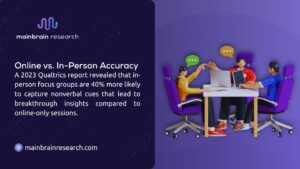The market research industry pulled in $140 billion in 2024, and a significant chunk of that went to focus group market research.
Why does this matter? Because 58% of researchers still run in-person focus groups, even though we’ve got AI tools, big data analytics, and enough digital surveys. Companies like Disney built their $55 billion merchandising empire partly on insights from focus groups.
Dove’s “Real Beauty” campaign – the one that doubled their sales from $2.5 billion to $4 billion – came from listening to women talk to each other about beauty standards in focus group settings.
The thing about focus group market research is that it captures something numbers can’t. When someone says they’d “probably buy” your product on a survey, that’s nice. But when you watch their face light up as they handle a prototype and start telling stories about how they’d use it?
That’s the kind of insight that actually moves the needle. While quantitative market research tells you what’s happening, focus groups show you why it’s happening, and that “why” is where the money is.
What Happens in Focus Group Market Research
Focus group market research brings together 6 to 10 people who have something in common. Maybe they all buy organic food, or they’re all switching phone carriers, or they all tried your competitor’s product last month. These people spend 60 to 90 minutes talking about whatever you need to understand, guided by a moderator who knows how to keep things moving without steering the conversation too hard.
The magic happens in the interaction. Someone mentions they hate complicated checkout processes, and suddenly three other people are chiming in with their own checkout horror stories. One person’s complaint triggers another person’s memory, and before you know it, you’ve uncovered a pattern you never would’ve found asking people questions one by one.
This approach traces back to the 1940s when researcher Robert Merton figured out that people share more when they’re comfortable and surrounded by others like them. He was testing World War II propaganda, but the insight stuck around.
Businesses grabbed onto it after the war because they needed to figure out what would make their products sell, and it turns out watching people talk to each other about stuff reveals more than asking them to fill out forms.
The method works because it taps into how humans actually think and decide. We’re social creatures. We process ideas by bouncing them off other people. Primary market research like focus groups gives you direct access to that process.
| What You Get | How It Works |
| Real conversations | 6-10 people talking naturally about your topic |
| Reactions you can see | Body language, tone, excitement, hesitation |
| Ideas building on ideas | Participants spark thoughts in each other |
| Depth over breadth | Understanding the “why” behind behaviors |
| Flexibility | Moderators can chase interesting threads as they come up |
When Focus Group Market Research Makes Sense
Not every business question needs a focus group. Sometimes a quick survey works fine. But there are specific situations where focus group market research beats pretty much every other option.
Testing Ideas Before You Spend Real Money
Got a product concept that sounds great in the conference room but you’re not sure how actual customers will react? Focus groups let you test the waters without committing to full development. You can show rough prototypes, describe features you’re considering, or even just pitch the basic idea and watch what happens.
Learning how to do market research often starts here. With conversations that either validate your instincts or send you back to the drawing board before you’ve spent six figures on development.
The beauty here is speed. You can run three or four focus groups in a couple of weeks and come out knowing whether your idea has legs or needs serious reworking. Much faster than building the thing and hoping people buy it.
Figuring Out Why Your Marketing Isn’t Landing
Your ad campaign looked amazing in the agency pitch. You spent a chunk of change producing it. And then… crickets. What went wrong? Focus groups can tell you.
Show people your marketing materials and watch them react in real time. You’ll see what confuses them, what makes them skeptical, and what (if anything) gets them excited.
Men’s Wearhouse discovered through focus groups that guys don’t just want affordable suits, rather they desperately want to look good at big moments in their lives. That insight (“You’ll like the way you look”) turned into positioning that changed their entire business. That’s what good focus group market research can do.
Understanding Complicated Customer Experiences
Some things are just hard to capture in a survey. How do people actually use your software? What’s the experience of shopping in your store? Why do customers start the checkout process but never finish?
These questions involve multiple steps, emotions, and often things people don’t consciously think about. Focus groups give them space to walk through their experiences, remember details, and explain the little frustrations or delights that drive their behavior.
Adding Context to Your Data
Maybe your survey told you that 40% of customers rate your customer service as “poor.” Okay, but what does that actually mean?
- Are your wait times too long?
- Are your reps rude?
- Is your phone tree a nightmare?
- Are customers just grumpy that day?
Focus groups help you interpret the numbers by letting people explain in their own words what they mean when they check certain boxes. Combining different types of market research gives you both the big picture and the details.
Running Focus Groups That Don’t Waste Everyone’s Time
The difference between a focus group that generates breakthrough insights and one that produces obvious platitudes comes down to how well you plan and execute it.
Getting the Right People in the Room
Recruitment can make or break your research. You need people who actually know something about your topic, users of your product category, people in your target demographic, whoever makes sense for what you’re trying to learn.
But you also can’t just grab the first eight people who fit the profile. You need enough variety that people see things differently and push back on each other’s ideas, but enough commonality that they’re all relevant to your business questions.
The screening process usually involves some kind of survey or phone call to make sure candidates meet your criteria. And you need to think about practical stuff too. Can they actually show up at the time you’re scheduling? Are they in the right location for an in-person group?
Questions that Get People Talking
The moderator’s discussion guide shapes everything. Bad questions get you nowhere. “Do you like our product?” Great, everyone says yes because they want to be nice. That tells you nothing. Good questions make people think and share real experiences: “Walk me through the last time you tried to [do the thing your product helps with]. What was that like?” Now you’re getting somewhere.
Great moderators know their discussion guide inside and out but aren’t slaves to it. When someone mentions something interesting that wasn’t in the plan, skilled moderators know when to follow that thread. That flexibility is part of what makes focus group market research so valuable. Knowing which are the good market research questions is half the battle.
Where and How You Do It
If people feel uncomfortable or distracted, they won’t open up. In-person groups need comfortable spaces, decent snacks, and enough time at the start for people to relax before diving into the heavy questions. Nobody walks into a room full of strangers and immediately starts sharing their honest opinions about their insecurities or buying habits.
Online focus groups blew up during COVID and stuck around because they solve real problems. You can recruit people from anywhere instead of just within driving distance of your facility. Participants often feel less intimidated on camera from home than sitting in an unfamiliar office.
About 34% of qualitative research now happens via online focus groups with webcams, which makes sense given the advantages. Though you do have to deal with tech issues, internet problems, and keeping people engaged through a screen.
The Moderator Makes or Breaks Everything
Moderator skill determines your results. Good moderators do about seventeen things simultaneously—keeping discussion on track, making sure quiet people contribute, preventing loud people from dominating, noticing when someone looks skeptical even if they’re nodding along, probing deeper when answers seem surface-level, and keeping the energy up for 90 minutes straight.
The best moderators have this ability to make everyone feel heard while still controlling the direction of conversation. They catch the subtle stuff, such as the pause before someone answers, the glance between participants when a controversial point comes up, the shift in tone when the group moves from polite responses to real opinions.
What Focus Group Market Research Can (and Can’t) Do
Every research method has strengths and weaknesses. Focus group market research is incredibly good at certain things and pretty terrible at others. Knowing the difference keeps you from misusing the tool.
What Makes Focus Groups So Important
The depth of insight you get from focus groups is hard to match. People don’t just answer questions, they tell stories, share emotions, explain their thinking process, and show you how they really feel through body language and tone.
That richness helps you understand your customers as actual humans instead of data points. The importance of market research becomes obvious when you see how much more you learn from conversation versus checkboxes.
Group dynamics create insights that wouldn’t exist otherwise. One person mentions a use case for your product you never considered, and suddenly two others are saying “oh yeah, I do that too!” These connections between participants generate ideas that individual interviews would never surface.
Speed and efficiency work in your favor too. You can gather input from 8 people in 90 minutes, which beats scheduling eight separate hour-long interviews. For businesses that need answers quickly, especially startups doing market research, this efficiency matters. Plus, the cost per participant is reasonable compared to many other qualitative methods.
Where Focus Groups Fall Short
Small sample sizes mean you can’t treat focus group findings as statistically representative. Eight people can’t speak for eight million customers. This is why smart researchers use focus groups to understand patterns and generate hypotheses, then validate those findings with bigger quantitative studies.
Group dynamics cut both ways. The same interactions that spark insights can also create problems. Dominant personalities influence quieter participants. People might hold back unpopular opinions to avoid conflict.
The artificial setting of a research session doesn’t perfectly mirror real decision-making contexts. Even the best moderator can’t completely eliminate these issues, they can only manage them.
Recruiting challenges pop up, especially for niche audiences. Finding B2B decision-makers or people with rare characteristics who can all show up at the same time in the same place gets complicated. Virtual options help but don’t solve everything.
| What Works Well | What Doesn’t |
| Deep understanding of motivations and feelings | Representing large populations statistically |
| Capturing emotional reactions and body language | Avoiding all group influence and social pressure |
| Quick turnaround compared to big quantitative studies | Reaching extremely niche or geographically scattered audiences |
| Cost-effective per person | Predicting actual future behavior with certainty |
| Flexibility to follow unexpected insights | Working for every type of research question |
What to Do With Focus Group Insights
Running great focus groups is only half the job. The real value comes from analyzing what you learned and actually using those insights to make better business decisions.
This is where a lot of organizations drop the ball. They collect amazing insights and then… nothing changes.
How to Analyze Without Missing the Good Stuff
Proper analysis starts with getting everything down in writing. Transcribe the sessions so you can review discussions carefully and catch things you missed during the live conversation.
Many research teams use qualitative analysis software to tag comments by theme, track how often certain topics come up, and organize the mountain of data into something manageable.
But don’t just focus on what people said, pay attention to how they said it.
- Was there excitement in their voice?
- Did they hesitate before answering?
- Did they light up talking about one feature but seem bored discussing another?
- Did multiple people lean forward when a specific topic came up?
These signals tell you what really resonates versus what people think they’re supposed to care about. Running multiple focus groups helps separate individual quirks from real patterns.
When the same themes pop up independently across different groups in different locations, you can feel more confident that those insights reflect broader truths. The benefits of market research multiply when you’re systematic about validation.
Presenting Findings So People Listen
Research reports need to make insights impossible to ignore. Use actual quotes from participants to bring findings to life. Nothing hits harder than reading a customer’s exact words describing their frustration with your checkout process. Video clips work even better when you can show stakeholders the emotion behind certain reactions.
But don’t just dump a bunch of quotes and call it done. Connect what you heard to what it means for the business. “Participants complained about X” is a finding. “Participants complained about X, which explains the 40% cart abandonment rate we’re seeing, and we should address it by doing Y” is actionable insight.
Decision-makers who didn’t attend the sessions need enough context to understand where recommendations come from. Show them the richness of the discussion through carefully chosen examples. This transparency builds confidence in your conclusions and helps people understand the nuance behind seemingly simple recommendations.
Start Knowing What Your Customers Really Think.
Every business leader makes assumptions about their customers. The difference between companies that thrive and those that struggle often comes down to which leaders test their assumptions and which ones just hope they’re right.
Focus group market research gets you past the guesswork. But running focus groups that actually deliver valuable insights takes experience. Knowing how to recruit the right participants, craft questions that go beyond surface answers, moderate discussions that reveal real truths, and analyze findings in ways that drive action.
MainBrain Research has been doing this long enough to know what works. Our moderators know how to create environments where people open up. Our analysis connects those insights to your specific business challenges and opportunities.
Don’t base major decisions on assumptions when you could have actual customer insights driving your strategy.



















